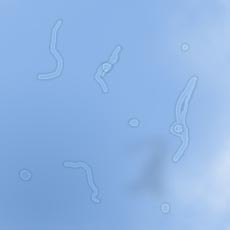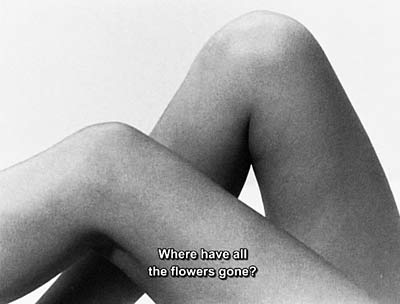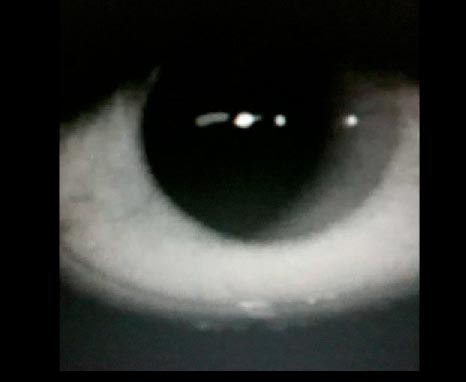eyes
Ah mah gah

It looks like the future is finally here. I wasn’t quite sure how it was going to present itself, but it seems to have come in the form of UC Berkeley scientists who have developed a “decoder” that can measure our brain activity and reconstruct our visual experiences. In other words, 20 years from now we might not ask eye-witnesses to describe a suspect… we’ll just analyze their brain activity and reconstruct the suspect’s image for ourselves.
photo { Howard Bond, Car Hood I, Ontario, 1984 }
‘Talent hits a target no one else can hit; Genius hits a target no one else can see.’ –Arthur Schopenhauer
When looking at a picture of many trees, young people will tend to say: “This is a forest.” However, the older we get, the more likely we are to notice a single tree before seeing the forest. In a new study published in the July-August issue of Elsevier’s Cortex, researchers have found that these age-related changes are correlated with a specific aspect of visual perception, known as Gestalt perception.
Put a bird on it

Cramer’s company, HyperStealth Biotechnology Corporation… (…)
Over the past 10 years, Cramer, 43, has created more than 8,000 unique camouflage patterns. Ultimately none may have more influence than his most recent design. In April, the United States Army issued a request for proposals for a new family of camouflage patterns to replace the Universal Camouflage Pattern design that’s been the Army’s general-issue print since 2004. Cramer is expected to be among the top contenders for the contract to create a family of patterns and palettes that can function nearly anywhere in the world. (…)
The next half-step breakthrough in concealment might well be something called “adaptive camouflage.” “We’re working on materials that can change their color, shape, and brightness, depending on the surrounding environment.”
photo { Todd Fisher }
I’m not that genie in a bottle, I’m in a bag

Sometimes when I’m lying on my back looking at the sky or the ceiling or some other light-colored background, I swear I can see specks and what looks like little threads floating by. They seem to move when I move my eyes, leading me to believe they’re actually on my eyes. Is there some optical phenomenon that allows us to focus that close? Is there a name for this effect?
{ The Straight Dope | Continue reading }
Floaters are deposits of various size, shape, consistency, refractive index, and motility within the eye’s vitreous humour, which is normally transparent.
Since these objects exist within the eye itself, they are not optical illusions but are entoptic phenomena.
One specific type of floater is either called Muscae volitantes (from the Latin, meaning ‘flying flies’), or mouches volantes (from the French), and consist of small spots. These are present in most people’s eyes and are attributed to minute remnants of embryonic structures in the vitreous humor.
Where did Triton come from?

Paying attention to something and being aware of it seem like the same thing -they both involve somehow knowing the thing is there. However, a new study, which will be published in an upcoming issue of Psychological Science, a journal of the Association for Psychological Science, finds that these are actually separate; your brain can pay attention to something without you being aware that it’s there. (…)
Hsieh suggests that this could have evolved as a survival mechanism. It might have been useful for an early human to be able to notice and process something unusual on the savanna without even being aware of it, for example. “We need to be able to direct attention to objects of potential interest even before we have become aware of those objects,” he says.
photos { Jane Fulton Alt }
‘Always contented with his life, and with his dinner, and his wife.’ –Pushkin

{ screenshot from Naked Ambition An R-Rated Look at an X-Rated Industry, 2009 }
related:

Video means I see in Latin

Some blind people are able to use the sound of echoes to “see” where things are and to navigate their environment. Now, a new study finds that these people may even be using visual parts of their brains to process the sounds.
Echolocation is best known in bats, who send out high-pitched sounds and then use the echoes to track their prey in the dark. But a select few blind people use echolocation as well, making clicking sounds with their tongues to tell them where obstacles are. The new study, published May 25 in the open-access journal PLoS ONE, is the first to peer into the brains of blind people who are doing just that.
The study finds that in two blind men who can echolocate, brain areas normally associated with vision activate when they listen to recordings of themselves echolocating.
photo { Victor de Mello | Hannah Marshall, Autumn/Winter 08-09 }
The night has a thousand eyes

“It is a surprise that a jellyfish — an animal normally considered to be lacking both brain and advanced behavior — is able to perform visually guided navigation, which is not a trivial behavioral task,” said lead researcher Anders Garm of the University of Copenhagen. (…)
Box jellyfish have 24 eyes of four different types, and two of them — the upper and lower lens eyes — can form images and resemble the eyes of vertebrates like humans. The other eyes are more primitive. It was already known that box jellyfish’s vision allows them to perform simpler tasks, like responding to light and avoiding obstacles.
In the new study, scientists found that one species of the cube-shaped box jellyfish, Tripedalia cystophora, uses its upper lens eyes, which are mounted on four cuplike structures, to make sure it stays close to the prop roots of mangrove trees that define its habitat.
artwork { Ellen Gallagher, DeLuxe, 2004–05 [detail] | currently on view at the MoMA, NYC }
‘I’m afraid of losing my obscurity. Genuineness only thrives in the dark. Like celery.’ –Aldous Huxley
Our eyes jump rapidly about three times each second to capture new visual information, and with each jump a new view of the world falls onto the retina — a layer of visual receptors on the back of the eye.
However, we do not experience this jerky sequence of images; rather, we see a stable world.
They may be the same objects in different stages of a repeating cycle
“Red, ‘bloodshot’ eyes are prominent in medical diagnoses and in folk culture”, said lead author Dr. Robert R. Provine from the University of Maryland, Baltimore County. “We wanted to know if they influence the everyday behaviour and attitudes of those who view them, and if they trigger perceptions of attractiveness.”
Research published in Ethology finds that people with bloodshot eyes are considered sadder, unhealthier and less attractive than people whose eye whites are untinted, a cue which is uniquely human. (…)
“Standards of beauty vary across cultures, however, youth and healthiness are always in fashion because they are associated with reproductive fitness,” said Provine. “Traits such as long, lustrous hair and smooth or scar-free skin are cues of youth and offer the beholder a partial record of health.
Now clear eye whites join these traits as a universal standard for the perception of beauty and a cue of health and reproductive fitness. Given this discovery, eye drops that ‘get the red out’ can be considered beauty aids.”
The way in which the other presents himself, exceeding the idea of the other in me, we here name face

Humans are known to have the largest and most visible sclera – the “whites” of the eyes – of any species. This fact intrigues scientists, because it would seem actually to be a considerable hindrance: imagine, for example, the classic war movie scene where the soldier dresses in camouflage and smears his face with green and brown pigment – but can do nothing about this conspicuously white sclera, beaming bright against the jungle.
There must be some reasons humans developed it, despite its obvious costs. In fact, the advantage of visible sclera – so goes the “cooperative eye hypothesis” – is precisely that it enables humans to see clearly, and from a distance, which direction other humans are looking.
Chimpanzees, gorillas, and bonobos – our nearest cousins – follow the direction of each other’s heads, whereas human infants follow the direction of each other’s eyes.
{ Brian Christian, The Most Human Human | via Overcoming Bias | Continue reading }
photo { Salvador Dali by Richard Avedon, 1963 }
no hair down there = gross

Does monocular viewing affect judgement of art? According to a 2008 paper by Finney and Heilman it does. The two researchers from the University of Florida inspired by previous studies investigating the effect of monocular viewing on performance on visual-spatial and verbal memory tasks, attempted to see what the results would be in the case of Art.
In particular, they recruited 8 right-eye dominant subjects (6 men and 2 women) with college education and asked them to view monocularly on a colour computer screen 10 painting with the right eye and another 10 with the left. None of the subjects was familiar with the presented paintings. Overall, each subject viewed 5 abstract expressionist and 5 impressionist paintings with each eye. (…)
Monocular viewing had significant effects only in paintings in the abstract expressionist style. Impressionist paintings yielded no differences.
painting { Willem de Kooning, Figure with Red Hair 1967 }
Gentil n’a qu’un oeil

The human eye is an amazing piece of machinery. It can distinguish some ten million colours thanks to the remarkable light-sensitive rod and cone cells that populate the back of the eye.
These cells neatly divide up the process of vision. The rods, some 90 million of them, have a peak sensitivity to reddish light and work best in low light, providing our night vision.
The cones, on the other hand, some 5 million of them, come in three types. These are sensitive to long wavelengths (ie red), medium wavelengths (green) and short wavelengths (blue) producing colour vision. They are designated L, M and S cones respectively.
But here’s the puzzle: S cones are rare making up less than 10 per cent of the total. The L and M cones are much more common but their ratio can vary dramatically. People with otherwise normal colour vision can have L:M ratios of between 1:4 and 15:1.
(Other primates have different ratios although the ratio in new world monkeys is similar to ours.)
The question that leaves biologists scratching their heads is why.
One idea is that this distribution of cone cell types is the result of an adaptation to the environment in which the human eye evolved.
So if we can work out what that environment was like, we could get a handle on the forces that shaped our visual system.
You ask me, how can you set me free, and I tell you, it’s so easy
The simple act of closing our eyes has a significant effect on our moral judgement and behaviour. Eugene Caruso and Francesca Gino, who made the observation, think the effect has to do with mental simulation, whereby having our eyes closed causes us to simulate scenarios more vividly. In turn this triggers more intense emotion. (…)
Overall, there was no evidence that the eyes-closed participants had simply paid more attention to the scenario than the eyes-open participants, but they did experience more negative, guilt-based emotion and it’s this effect that probably underlies the study’s central finding.
‘The true is the whole.’ –Hegel

Loud bangs, bright flashes, and intense shocks capture attention, but other changes – even those of similar magnitude – can go unnoticed. Demonstrations of change blindness have shown that observers fail to detect substantial alterations to a scene when distracted by an irrelevant flash, or when the alteration happen gradually.
Here, we show that objects changing in hue, luminance, size, or shape appear to stop changing when they move. This motion induced failure to detect change, silencing, persists even though the observer attends to the objects, knows that they are changing, and can make veridical judgments about their current state. Silencing demonstrates the tight coupling of motion and object appearance.
During silencing, rapidly changing objects appear nearly static, which raises an immediate question: What is the perceived state at any given moment? To illustrate, consider an observer who fails to notice an object change gradually from yellow to red. One possibility is that the observer always sees yellow, never updating his percept to incorporate the new hue – this is freezing, erroneously keeping hold of an outdated state. Another possibility is that he always sees the current hue (e.g. yellow, orange, then red) but is unaware of the transition from one to the next – this is implicit updating.
{ Motion Silences Awareness of Visual Change via Thoughts on thoughts | Continue reading }
photo { Christopher Williams }
Like him was I, these sloping shoulders

White men with brown eyes are perceived to be more dominant than their blue-eyed counterparts. However, a blue-eyed man looking to make himself appear more dominant would be wasting his time investing in brown-coloured contact lenses. A new study by Karel Kleisner and colleagues at Charles University in the Czech Republic has found that brown iris colour seems to co-occur with some other aspect of facial appearance that triggers in others the perception of dominance.
Sixty-two student participants, half of them female, rated the dominance and/or attractiveness of the photographed faces of forty men and forty women. All models were Caucasian, and all of them were holding a neutral expression. Men with brown eyes were rated consistently as more dominant than blue-eyed men. No such effect of eye-colour was found for the photos of women. Eye colour also bore no association to the attractiveness ratings.
Next the researchers used Photoshop to give the brown-eyed men blue eyes and the blue-eyed men brown eyes. The photos were then rated by a new batch of participants. The intriguing finding here was that the dominance ratings were left largely unaffected by the eye colour manipulation. The men who really had brown eyes, but thanks to Photoshop appeared with blue eyes, still tended to be rated as more dominant.
photo { Richard Avedon, Billy Mudd, Trucker, Alto, Texas, May 7, 1981 }
But once in a while you might see me at In and Out Burger
Things that appear on the left are better remembered
The aim of the present study was to investigate whether neurologically intact individuals demonstrate a lateralized bias in remembering mental images of recently presented novel material comprising arbitrary combinations of shape, colour, and location in a temporary memory binding paradigm. The material involved arrays of a small number of simple geometric or animal shapes, so as to make it very unlikely that there would be any difficulties in perception, thereby focusing on memory. Recall was assessed by asking participants to report stimulus features using a forced-choice task in which they selected the colour, shape, and location of each item shown in the study array. In three related experiments, we report evidence of a new phenomenon: a leftward bias when people try to remember visually presented novel information.
To be sure, poor fellow. So it is. What time?
During REM sleep, where most dreaming takes place, your eyes move around but it’s never been clear exactly why. A new study just published online by neuroscience journal Brain suggests that they are looking at the ever-changing dream world.
The first question you might ask is how the researchers knew what the dreamers were looking at. To study this, the project recruited people with a condition called REM sleep behaviour disorder who lack the normal sleep paralysis that keeps us still when we dream.
In other words, people with REM sleep behaviour disorder act out their dreams. (…) When the eyes move during REM sleep they are looking at something in the dream world. The eyes seem genuinely to be a bridge between the land of dream consciousness and waking life.










